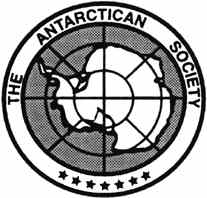
The Antarctican SocietyWhere Antarcticans go when they leave the IceBy Kristin LarsonSpecial to the Sun(originally published 6 February 2000)I've never been much of a joiner. Clubs and societies, at least those possessing any degree of self-importance, just don't appeal to my social instincts. I prefer, at most, the company of a few like-minded friends. I suspect this is true for most Antarcticans; a group of rugged individualists if ever there was one. Ironically, these same isolation-seekers willingly check their independence at Christchurch each year as a condition of their trip south. An ephemeral community composed of loners. Oddly oxymoronic isn't it? Or not. After dozens of ice months and a few winters, I have not only joined a club as an active member, but also serve as an editor of its newsletter. It is a club for loners: The Antarctican Society. The Antarctican Society has colorful, if not bawdy, roots as an "old boys" drinking club. Carl Eklund, freshly home from a year as leader at Wilkes Station (formerly a U.S. station, now the Australian Casey Station), was known to enjoy the company of his fellow International Geophysical Year cronies. As the story goes, Dr. Eklund frequently entertained this august group in his D.C. basement, which was outfitted with a wet bar and elephant's foot kitty jar.  These communal and legendary events occurred throughout the late 1950s and into the 1960s. By 1970 the club was welcoming both genders and had taken the bold step of adopting a charter and bylaws. In parallel with the opening of the Antarctic continent, the Society has became increasingly organized, accessible, and of interest to a growing cross-section of people. Initially, the Antarctican Society was composed of beltway types: researchers, government officials and even some diplomats. These were the pioneers of the continent and framers of the treaty that now governs it. At one time more than half of the members had geographic places in Antarctica named for them, and better than 65 percent were D.C. based. That percentage is now less than a third of the 500 members who around the globe. Happily, many of the earliest members are still active and influential in the Society. Imagine being in a room with Galileo, Napoleon, Plato, Jefferson, Lincoln and Cady Stanton. Imagine being given unlimited opportunity to ask questions about what it was like shaping the contours of the social order we have inherited from their hands. That's what it's like going to an Antarctican Society meeting! Because the entire history of human endeavor in Antarctica reaches back only a few hundred years, and because most substantial advances have occurred in the past 60 years or so, it is still possible to hang out with the founding fathers--and mothers. Firsthand accounts of early traverses, mapping expeditions and a host of other "firsts" are standard fare at Society meetings, as is the tradition of sponsoring an Antarctic-oriented speaker. So what's the point of this article? In part, I wanted to bring the existence of this society to your attention, the latter-day ice people. Who knows? You may want to join. More importantly, maybe you should join. After all, in another fifty years it will be you and me spinning our yarns about our rugged icebound days, reminiscing about the South Pole before the ice sheets melted. Joining is easy and cheap. For twelve dollars a year, the newsletter is delivered directly to your mailbox (yes, we do it the old-fashioned way) approximately 5 times a year. In this newsletter you will learn about the goings-on of all things Antarctic, ranging from the political and environmental to current research breakthroughs and even plain old scuttlebutt about your pals and fellow ice-mates from around the world. Lest you get me wrong, I did not contribute this write-up as a bald-faced plea for new members. The truth is we have more than ample membership. Rather, this write-up is a call to those of a more recent vintage to consider becoming at least loosely associated with the Society as a means of staying updated on events, contributing news, gossip artwork, and even finely crafted literature. We are, after all, alumni of a pretty special place, a common ground for stories and shared interests. The Society's goal is to nurture this network. Lastly, I would like to extend an invitation to those of you who are wintering-over to e-mail news of the icebound. We would love to run a winter-weirdness column! Kristin Larson is a former supervisor of the Eklund Biological Center and Crary Lab and was the assistant for environmental compliance in the Office of Polar Programs.[online memberships are $13; mail delivery memberships are more depending on your location. Check out this page on the Society website to sign up or to print out a membership application. Also note that I've edited this article slightly to update old information--Bill.] |